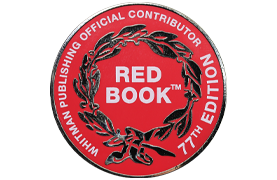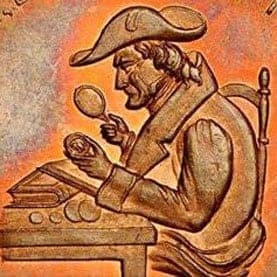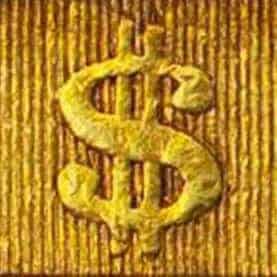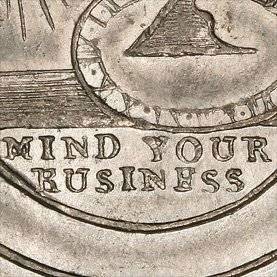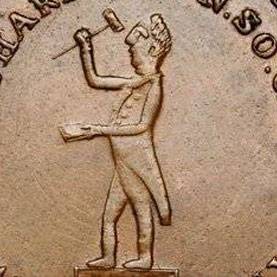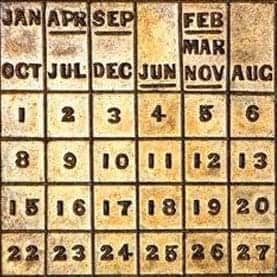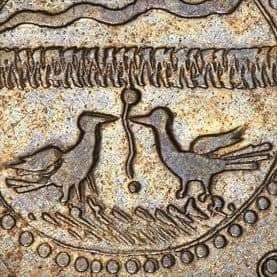February 6, 2015: CRO’s View of the Donald Partrick Collection, Part I
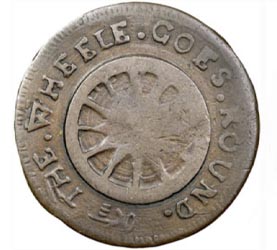
Forthwith we are pleased to present our usual CRO-style review of the Donald G. Partrick Collection, Part I, which was auctioned by Heritage at the FUN Show this year.
And I have to say that when the news first broke in November of 2014 that this collection was coming to market soon, we, along with every other long time colonial dealer, collector, specialist, aficionado, fan, speculator, investor, grader, author and interested bystander, perked up.
Why? Because this collection has always been considered the colonial gold standard (even if a lot of us really did not know what was in it). Sure, we saw Mr. Partrick buy certain pieces in the Ford sales in the early 2000’s, and had heard about other coins that were supposedly in this set (unique Higley Wheel Goes Round, anyone?) but other than that fairly limited information, I doubt many of us knew what we were in for.
So it was with greater than usual anticipation that your author first perused the expertly cataloged and copiously illustrated Partrick Collection catalog in December, and then later headed down to Florida in early January for my first opportunity for some in-person lot viewing.
At which point I concluded that this wasn’t quite what I expected. Sure, there were a number of epic rarities and superb condition pieces that I knew would be here, and also some amazing coins I’d never seen before, but mixed in were some regular coins in regular grades that I would not have expected to see and which I was surprised were not replaced with better examples sometime in the last couple of decades. In short, it was an amazing assemblage, but not the ‘over the top, stop me in my tracks, everything here is the finest known’ kind of collection I had imagined.
With all coins again graded by NGC, and evaluated by CAC, with about the same % (i.e. not all that many) that I agreed with as in the last Newman colonial sale in November.
And with that let us begin, with our first notable lot #5504, the famous, finest and frankly breathtaking Birch Cent acquired by Mr. Partrick in the Garrett sale in 1981 and, of course, off the market ever since. Housed in what was an ‘It-would-never-be-graded-this-high-if-it-were-a-common-coin-but-it-doesn’t-make-any-difference’ MS65* RB NGC holder verified by CAC (this and other pictures in this article courtesy of Heritage):
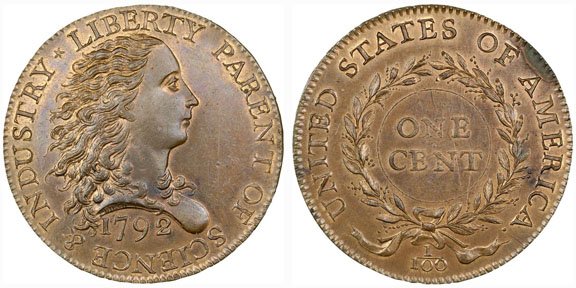
Shockingly (to me, anyway) it realized ‘just’ $2,585,000, which is a lot of money in the real world, of course, but about $2,000,000 less than I was expecting on this night. Seriously, that seemed like a fantastic deal for what is to me one of the most desirable numismatic items in existence (some of which have sold for waaaay more than that in recent years).
After which we made our way to the colonial issues, starting with a run of six New England Shillings representing four different die varieities, ranging in grade from NGC Details – Scratches at the low end to lot #5517 on the high side, a lovely and accurately graded NGC AU58 specimen verified by CAC:
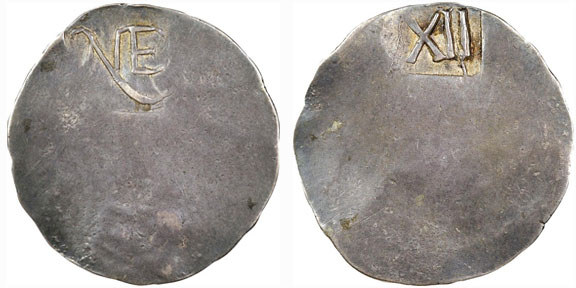
Not surprisingly, this was the most expensive of the NE group at $293,750, but that was considerably less than some inferior ones have brought in recent years, and about 15% less than this same coin realized in its last appearance at the Ford sale in October of 2005.
Followed soon after by lot #5519, the nicest Willow Tree Shilling in the collection, and while I would have liked it better if it was more round in shape, it was as made, really wholesome, with fabulous color, graded reasonably as XF45 by NGC, verified by CAC and brought a very fair $188,000:
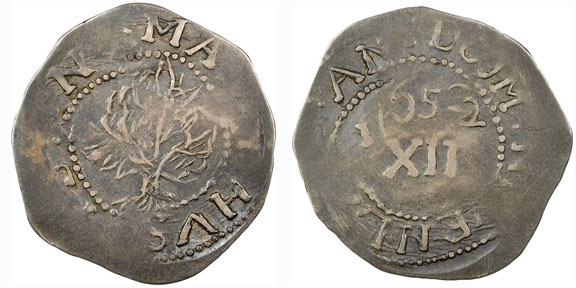
But while those seemed like good value to me, I did not feel that way across the board, with perhaps lot #5531, a 1652 Oak Tree Shilling graded MS65+ and verified by CAC, illustrative of this point:
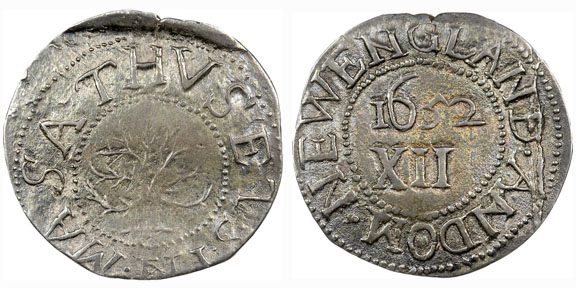
That one realized $105,750, which is just about $90,000 higher than I valued it during lot viewing (since I covered the slab labels that day, thought this was a pretty typical AU and figured it for 15 grand). About which I can conclude three things: 1. It was pretty clear I was not going to be the high bidder, 2. Obviously someone (actually several someones) saw that one a lot differently than I did, and 3. Variety, it is the very spice of life.
On the other hand, lot #5584, the finest known Noe-11, No H in MASATUSETS Pine Tree Shilling in what I thought was a well-deserved NGC MS64+ slab verified by CAC brought less than I expected at $74,300:
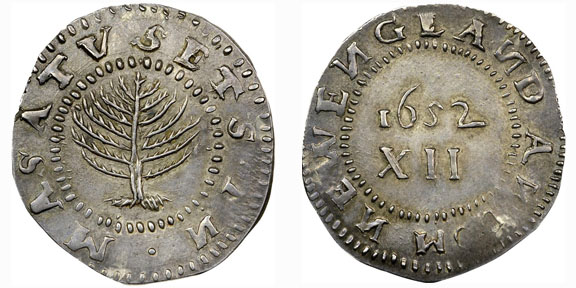
Which explains why I bought it. Also interesting about this piece: It is illustrated in Sylvester Crosby’s Early Coins of America published in 1875 as a distinctively shaped and wholly recognizable woodblock print:
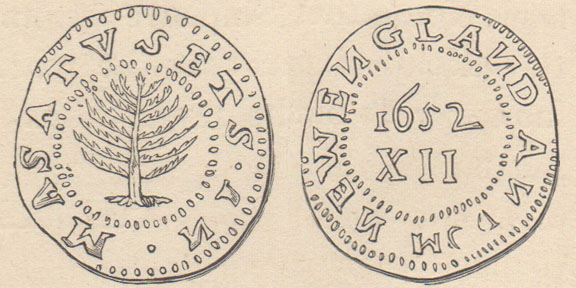
How cool is that?
And that was just one of a number of pieces with famous and important pedigrees in this sale, with most of those noted on the slab labels and described in detail in the catalog. But some others weren’t, including on lot #5609, this distinctive, full legend Noe-33a Pine Tree Sixpence in an NGC MS64 CAC approved slab:
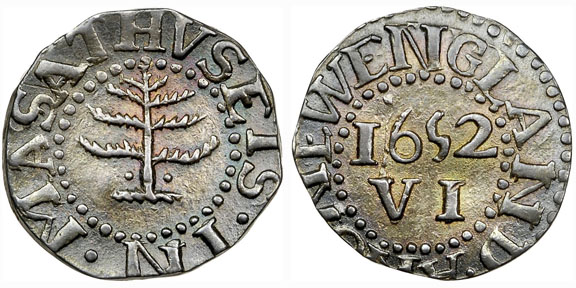
That one was listed merely as “Ex Hanson” in the catalog (referring to Mr. Partrick’s dealer of choice Jon Hanson), but the distinctive shape of this piece (and the fact that it is about the best centered one in existence) made it instantly recognizable as a coin which last appeared on the market in Stack’s October 1984 sale of the Richard Picker Collection, lot #39, there described as “Ex Ellsworth and Garrett collections, privately”. The old image of that coin is forever etched in my brain since it has always been in my photographic census rankings of this issue, but it was interesting to see it here in hand for the first time.
Speaking of old pictures, we then came to lot #5626, the Maryland Shilling with sharp detail but harshly cleaned, oddly unnatural surfaces rightfully housed in an NGC Unc. Details – Improperly Cleaned slab which brought an appropriate $24,675:
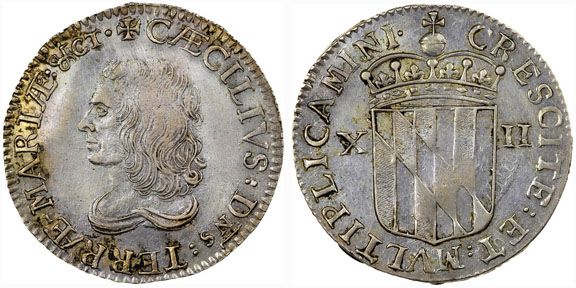
I recognized this one too, since it is actually the Breen Encyclopedia plate coin for the issue and looks fantastic there:
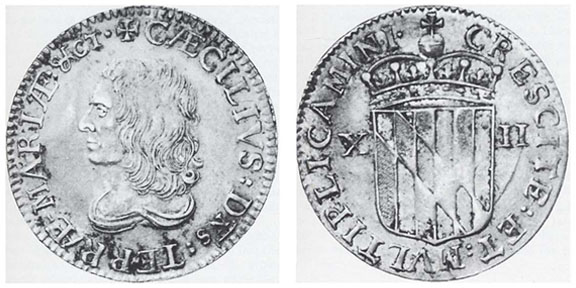
Based on those old black and white images this is another coin I had high in my condition census rankings for many years. Until I saw it in hand here. Odd that Walter Breen used a cleaned one for the plate photo, isn’t it?
The next surprising piece to me was lot #5629, the circa 1670 New Yorke in America token graded NGC AU50 and not verified by CAC which realized $61,687.50:
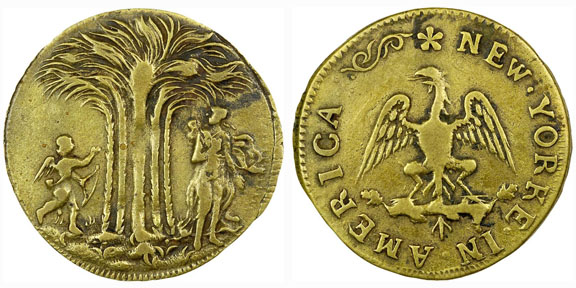
That’s quite a step up from the last appearance of this coin in Bowers and Merena’s November 2002 Baltimore auction, lot #31, where it was offered raw, was brightly cleaned, graded VF and realized $12,650. Personally, I thought that old Bowers catalog assessment was pretty accurate.
And then we were on to the Higleys, culminating with lot #5637, one of the most famous colonial coins in existence, the 1737 Higley Wheel Goes Round which last saw the light of day 32 years ago in Stack’s December 1983 Roper Collection sale, earlier ex-Garrett. This is one of a handful of unique coins in the entire colonial series and in my opinion the single most iconic, recognizable and desirable of them:
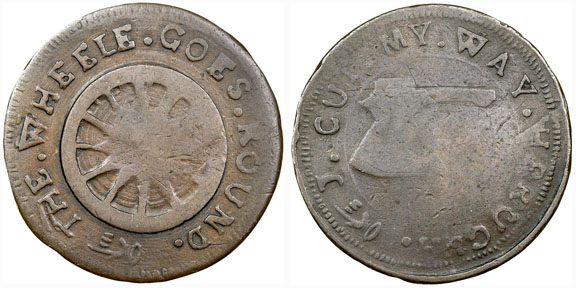
And frankly I was stunned that it brought ‘just’ $376,000. Pre-sale I figured it for more like $600,000 hammer, and would not have been too surprised to see it bring more than that to one of the current generation of well-heeled specialist collectors in what might have been their one and only chance to own it.
With our next featured lot #5659, a nice, original 1783 Chalmers Shilling, Short Worm variety housed in an ambitious NGC XF45 slab not verified by CAC:
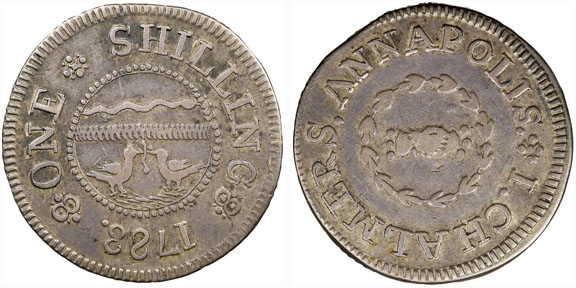
That was a pleasing mid-grade piece that sold for an appropriate price of $8,225, but not exactly the kind of coin one might have expected to find in the greatest colonial collection ever formed (especially since there had been many, many chances to obtain a higher grade piece through the years).
But there had been only one single chance in the last 107 years (at the Garrett sale in 1979 to be precise) to buy the next item on our list, the mysterious, unique and actually very pleasing light chocolate brown “1776” Massachusetts Janus Copper in a VF35 NGC holder verified by CAC:
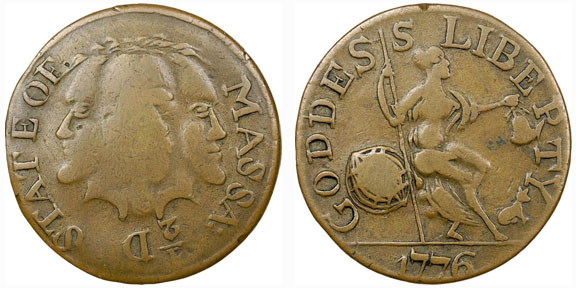
I distinctly remember seeing that for the first time in the Redbook when I was a kid and dreaming about owning it, and I suspect I am not the only one. But a lot can change in 36 years (for example, you can now purchase rare numismatic items in your pajamas while bidding on a device called a ‘smart phone’, options unavailable to bidders in the late 1970s). Something else that changed in the intervening 36 years: The perception of this coin, since at this point many people aren’t sure exactly what it is, who made it, or when. Which explains why it brought ‘only’ $44,650.00 on this night (almost exactly the same as the $44,000 it brought in Garrett).
No such controversy surrounded Mr. Patrick’s august regular issue Massachusetts copper collection, which came up next, and included a cavalcade of condition census pieces and rare varieties and represented the highest quality portion of this session. Including coins like lot #5699, the finest 1787 Massachusetts Cent in the offering, graded an accurate (in your author’s view) MS66 BN by NGC and verified by CAC:
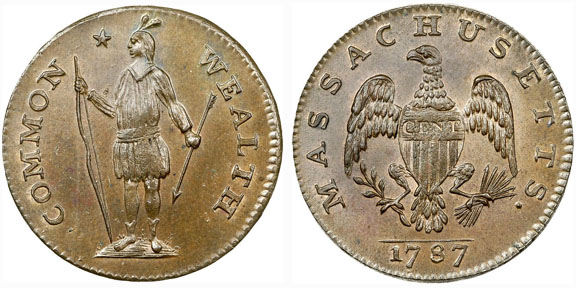
That realized an about as expected $37,600. Which was exactly the same price as lot #5711, the finest 1788 Massachusetts Cent, ex Norweb, also graded MS66 and verified by CAC:
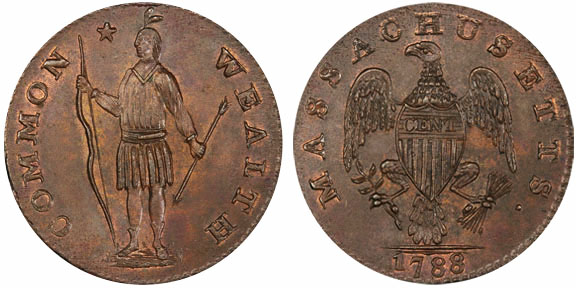
1788s are considerably tougher than 1787s in high grade, making that one seem like a relative bargain to me. I also thought it was also an absolute knockout with great luster and mint red lingering on both sides, which explains why I bought it (then crossed it to PCGS, whose image appears above).
With the Massachusetts pieces followed by the Vermont Coppers, a set acquired mostly from Q. David Bowers and notable for its completion, if not its quality. But it started well with lot #5735, one of the three best 1785 Vermont Immune Columbia Ryder-1’s I’ve personally seen or know about, and a coin which has been in my census of the variety ever since I saw a photograph of it years ago at a Bay State Show in Boston. Alas, I never got to copy the photo, and I didn’t know who owned it. Until now. And I agreed with the NGC grade of VF35, verified by CAC, and selling for about what I expected at $54,050:
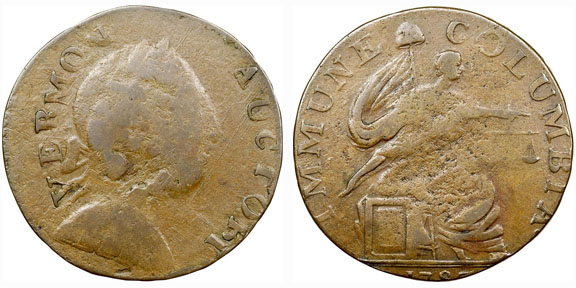
Followed shortly thereafter by lot #5758, a 1786 Vermont Bust Left, Ryder-11 in an NGC Details holder labeled Environmental Damage, Obverse Tooled:
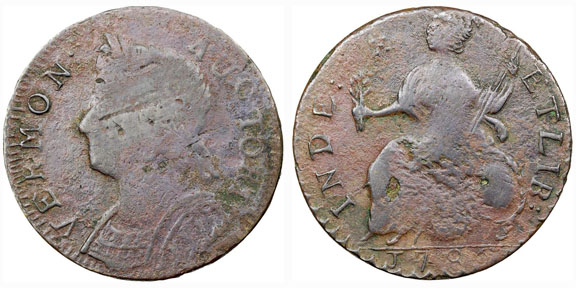
Now, that was not the greatest coin I’ve ever seen, but I did want to highlight it since it was the single most affordable piece in the entire Partrick offering at $329 (though honestly that seemed really strong for that item).
On the other hand, lot #5829, another NGC Details Vermont coin, this labeled Environmental Damage, looked even worse but realized a touch more at $18,800:
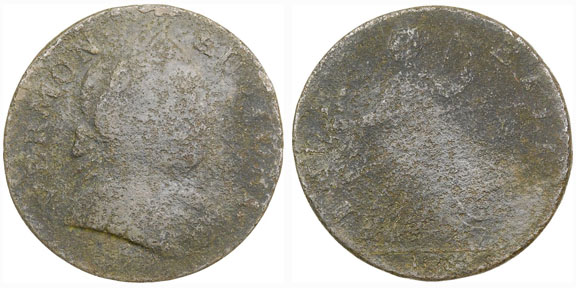
Of course this last one was a prohibitively rare Ryder-38 variety, one of 7 known, fought over by some unusually raucous Vermont floor bidders, some of whom had, by that point in the proceedings, liberally availed themselves of the wine from the bar set up in the corner of the room (not to suggest that that influenced the bidding – I’m sure it didn’t).
I personally did not drink at all though, as I was focused instead on a couple of highfalutin items coming up shortly thereafter, like lot #5838, a 1776 Continental Dollar in silver graded aggressively at XF40 by NGC and not verified by CAC:
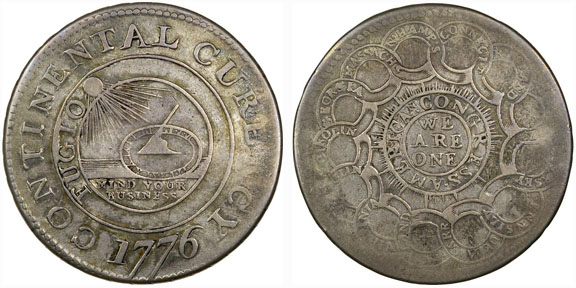
While some of the great rarities and famous coins ex-Ford in the sale brought less in this session than they had in earlier auctions, that was most definitely not the case here with the sale price of $1,527,500 more than 5 times the $287,500 it realized at Stack’s Ford Collection Sale, Part I, in October, 2003.
Ditto lot #5482, the 1776 Continental Dollar EG FECIT variety also graded aggressively at MS62:
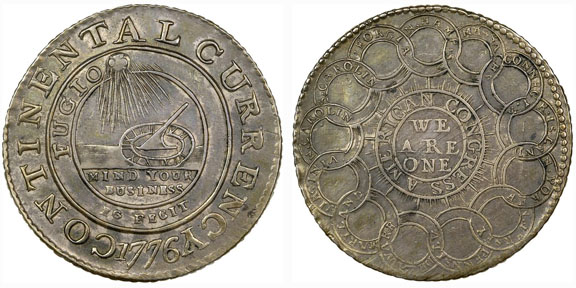
That one brought the exact same $1,527,500 here (indicating that grades don’t seem to mean much for coins like this), and also far exceeded its prior Ford price of $425,500 in that same 2003 auction, as well as the price of the finer Newman example sold last fall. Clearly silver Continental Dollars are hot!
And then the sale turned to the Confederate issues, and your author turned and left the room after what had been an interesting, exhilarating and very long session during which we bid on about 50 coins, bought about half of those and watched with great interest as some once-in-a-generation items fleetingly crossed the auction block.
Leaving us to wonder what will be coming up in the next session of Partrick coins slated for August of this year at the ANA.
Whatever it is, we’ll be there for that one too, and then dishing all about it here on this site in a free flowing style in which we’ll call it like we see it and almost certainly offend someone (or possibly everyone) in the process.
And that’s really all we have to say about that.

